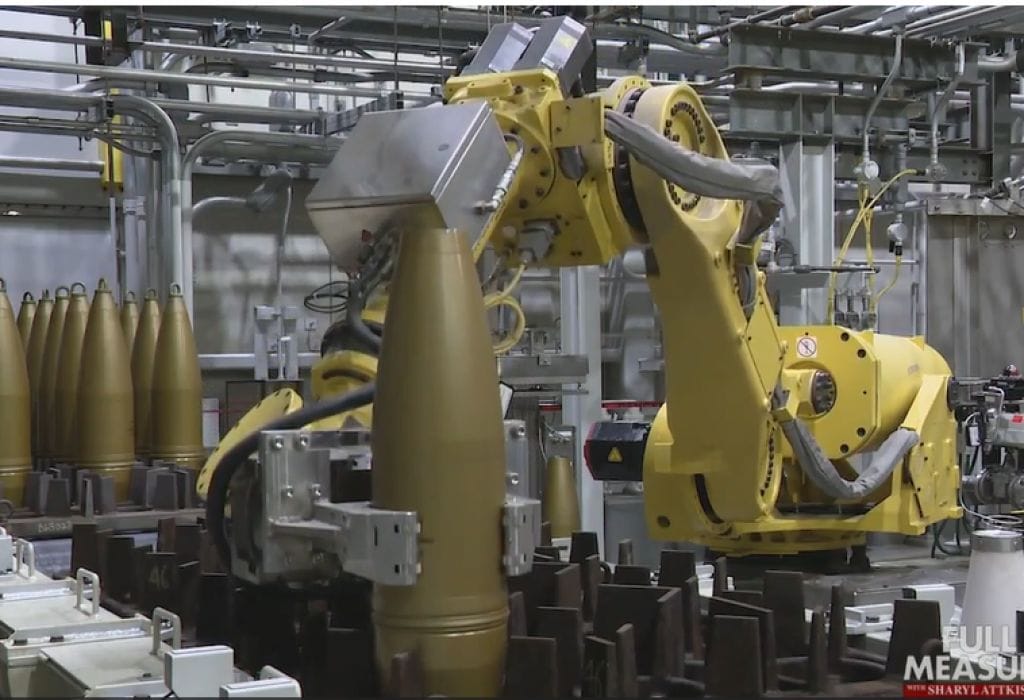
(Original air date: October 20, 2019)
The U.S. was among the other nations that used chemical weapons in World War One. Most of the world agreed to ban their use in 1993. Today, we’re on the short list of countries that still have stockpiles– But not for long. The military is finally destroying the last of these deadly chemical agents. Scott Thuman takes to the Blue Grass Army Depot for a fascinating inside look at the risky process.
In the scenic hills of rural Richmond, Kentucky, not far from the corner of First and Main – but out of sight – sits one of humanity’s worst inventions. So dangerous, it’s kept behind razor wire and armed checkpoints in these temperature controlled igloos. Just getting onto the base requires a blood test, and I’m issued a protective hood and three needles to inject myself if all goes wrong. That’s because this is America’s chemical weapons stockpile: Sarin – VX – and Mustard.
Craig Williams: You can think of it in terms of a pesticide for humans because that’s basically what it is. It attacks the central nervous system, and a droplet that would fit on the head of a ballpoint pen, if that was to get on my skin, 200 pound, six-foot tall person, I would have about three minutes to live. So that’s how lethal this material is.
That’s local veteran Craig Williams. He’s one of the reasons you now see this.
After years of test runs, weapons of mass destruction are slowly, and very carefully being opened on a highly automated production line designed and built for the job.
For those who have to sometimes go inside, the danger is unparalleled, preparations meticulous, and an emergency team is always suited up.
Scott: So anytime someone is in there working there are two people that are on standby ready to jump in?
Chemical weapons got their first widescale use in World War One and efforts to ban them began soon after that conflict. But it wasn’t until the 1990s that a worldwide treaty banning their production was signed. For years the US has been slowly eliminating its stockpiles – these rockets and artillery shells in Kentucky are the most dangerous of what’s left.
The mustard agent is destroyed in this custom built facility. The more lethal VX and Sarin, in another. We were allowed in during a practice run.
Scott: The real star of the show here is this robot which is essentially doing a job that you just don’t want people to do or they may not be able to do, it’s removing the VX or Sarin agent from these munitions and then moving on to the next stage.
It’s all done through combination of more than a thousand degrees of heat, water, pressure and a complex filtration system for the exhaust. Ron Hink runs the show here and has the resume to back it up, having helped clean up the reactor leak in Chernobyl, and destroy chemical weapons seized in Syria.
Scott:How much practice has gone into this?

Visit The Sharyl Attkisson Store today
Unique gifts for independent thinkers
Proceeds benefit independent journalism
Ron Hink: Yes. To exhaustion, I would say. Yeah. We will run drills. We’ve been, you know, if you’re out at the site, it’s very common to have a site agent release alarm go off and mask everybody. We train on that. We hope that never happens in real life in terms of agent release.
Scott: Because these are some of the most dangerous chemicals and chemical agents out there?
Ron Hink: Yeah, they were invented to harm, right? So they’re very good at what they do, but we’d like to think we’re very good at what we do and we train to make sure that we are.
But how that should be done, is where Craig Williams became a real thorn in the government’s side.
Craig Williams: Well, that’s how it was in ’84 when they came here and said, “You’ve got chemical weapons. We’re going to burn them. You got any questions?” That’s how this whole thing started.
Scott: You were shocked.
Craig Williams: Oh yeah. We didn’t know. So I raised my hand, and 35 years later I’ve still got my hand up.
Williams spearheaded efforts to make sure the weapons couldn’t simply be incinerated and then exit smoke stacks right next to a school.
Documentary: We will stop this incinerator!
For decades, he galvanized the public and created enough controversy, that the military changed procedures – devising a new, safer method of neutralizing the chemicals – with more thorough testing.
Safer, but never 100% safe for their workers in their thousand dollar, one-time use suits.
Scott: You’re going to be eradicating the last bit of chemical weapons in the U.S. You’re on this mission that’s really significant…
Dana: It is, you think back in history where this stuff was used, and I am now helping to destroy it, that’s a big thought if you just think about it.
Scott: Overseeing all this, do you at times feel kind of like a nervous parent?
Hink:Yeah, most days probably. Yeah. Because I think you worry about the team, the health and the morale and just where they’re at mentally, like a parent. The same time, you can be a proud parent watching what they can accomplish. So there’s both sides to that, right? There’s ups and downs. That’s what makes it fun.
The goal right now is to be finished at the end of 2023. There have been some delays as well as cost overruns. And just to give you a sense, eliminating this last part of the stockpile, what’s in Colorado and Kentucky is going to cost over 13 billion dollars.
https://fullmeasure.news/news/politics/chemical-weapons



In WWII Hitler did not use poison gas as anticipated by the allies who were prepared to respond with their own supplies of gas. An allied ship full of gas shells was delivering gas to Bara, Italy was attacked by a German aircraft and the ship exploded. The cloud of poisonous gas reached the shore and did a lot of damage to the town of Bara. It is a curiosity that as bad a human being as Hitler was that he did not order its use even when losing the war. It may have been due to his experience with poison gas in the trenches of WWI.
Hitler used up all his supplies in the gas chambers. Just ask the holocaust victims. Oh, that’s right; they all died from it.
Craig Williams has increased the risk to his community 10 fold by making himself a self appointed “expert” on demilitarization of CW. The other 8 communities where the weapons were also stored are now, and have been, safer for sometime now. The weapons at those sites were competently destroyed by incineration. Williams has been dishonest about the real risks in Richmond for many years now. Some people are so in love with their notoriety that they will put their neighbors at risk unnecessarily.
you’re right it has been a jobs program for Craig for over 25b years, this could have all been completed if the original plan of shipping everything to JI was completed but all the public comment periods and “studies” drove the cost of the Chem Demil Program from 1.2 to over 20 billion.